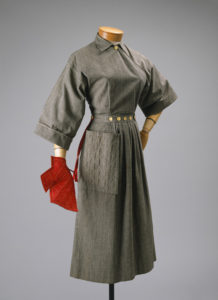
3. Claire McCardell, Time Magazine, 1955. Time Magazine archives.
Today as young women, we take for granted our ability to wear comfortable and stylish clothes that are both functional and fashionable. We have an array of shops to choose from when it comes to casual fashion, from Target to Topshop, women in the 21st century are spoilt for choice when it comes to fashion choices. However, as a young woman in the 1930s and beyond, obtaining affordable and casual clothes was a never-ending struggle to get the best dress for your dollar or pound. This is not to berate the fashion of the 1930s, as the fashions of the era is spectacular, it is simply stating that an ever increasing youth market wanted to look different from their parents’ generation.
This is where revolutionary fashion designer Claire McCardell stepped in, with her simple yet sophisticated approach to sports, causal and formal wear from the mid-1930s onwards. Claire was in 1905 in Frederick, Maryland and grew up wearing more masculine clothing, something that was to influence her designs throughout her career. Claire went to Paris in 1927, to study fashion and learnt about the tailoring, cut and feel of fabrics used in garment construction. Claire’s no nonsense approach to fashion was played out throughout her career; her dresses, playsuits, sportswear, and so on had clean lines, easy to wear fastenings and appealed to women of all ages.

2. Claire McCardell en route to Paris, 1927.
Originally, Claire worked for a designer called Robert Turk, of Townley Frocks, but when he tragically died in 1931, she was forced to finish his collection for that season. This collection was influenced by Paris as this is what sold in the 1930s; something that further fueled Claire to design fashion along her own lines. This ‘gung-ho’ spirit that Claire had led to her designing something that we take for granted in the 21st century; interchangeable separates to be worn with different outfits. Many women didn’t take to these immediately, but when they did Claire’s clothing became all the rage.
This happened when in 1941, people in the U.S. started looking to home grown designers for sartorial inspiration, as people could no longer travel to Paris as a result of the German occupation of France in June 1940. Claire McCardell excelled under this new interest in American fashion and debuted dirndl skirts, playsuits and a ‚ÄòMonastic‚Äô dress. This dress consists of one piece of fabric, with a belt tie around the middle and is easy to get in and out of. It is these simple yet sophisticated pieces that Claire became known for and appealed to women who¬†”Started talking about the ‚ÄòAmerican look‚Äô in fashion. It was fresh, spirited, young. It was made for healthy, long-legged girls who were going places and wanted clothes they could move in.”

Denim pop-over dress. Original possibly from Fashion Institute of Technology.
Claire continued to design dresses for various companies, but re-joined Townley later in her career and stayed with them until her death. Throughout WWII and beyond, Claire was making a name of herself with her various designs, including her ‘pop-over’ denim dress that was sold at $6.95 and as a Utility garment for busy wartime workers. Claire went onto become one of the first American designers recognized in her own right for her contribution to American fashion and the development of the ‘American’ look so popular in the 1940s and 1950s.
Claire McCardell died suddenly at the age of 53 in 1958, leaving behind a legacy that other designers have been influenced by or tried to emulate, but have never been able to garner the under-stated sophistication of Claire’s garments. Claire might be an unusual person to influence young girls and women; but at a time when the fashion industry was male dominated, she made a name for herself. Claire revolutionized how American (and other nationalities) women dressed and enabled women to wear more comfortable garments. Thus empowering women to undertake work outside of marriage, university education and furthering themselves in both their professional and personal lives.
-Rachel Sayers
Junior Girl
Girl Museum Inc.
